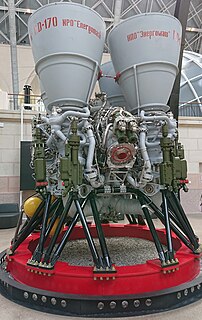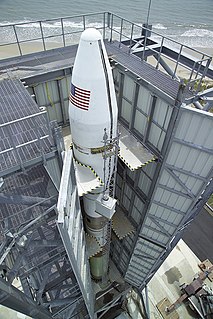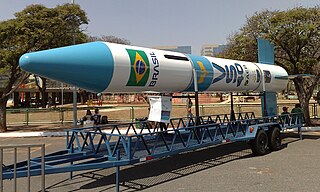Related Research Articles

The Black Brant is a family of Canadian-designed sounding rockets originally built by Bristol Aerospace, since absorbed by Magellan Aerospace in Winnipeg, Manitoba. Over 800 Black Brants of various versions have been launched since they were first produced in 1961, and the type remains one of the most popular sounding rockets ever built. They have been repeatedly used by the Canadian Space Agency and NASA.
The Dragon is a two-stage French solid propellant sounding rocket used for high altitude research.
Taepodong-1 was a three-stage technology demonstrator developed by North Korea, a development step toward an intermediate-range ballistic missile. The missile was derived originally from the Scud rocket and was tested once in 1998 as a space launch vehicle. As a space launch vehicle, it was sometimes called the Paektusan 1.

The Korea Aerospace Research Institute (KARI), established in 1989, is the aeronautics and space agency of South Korea. Its main laboratories are located in Daejeon, in the Daedeok Science Town. KARI's vision is to continue building upon indigenous launch capabilities, strengthen national safety and public service, industrialize satellite information and applications technology, explore the moon, and develop environmentally-friendly and highly-efficient cutting-edge aircraft and core aerospace technology. Current projects include the KSLV-2 launcher. Past projects include the 1999 Arirang-1 satellite. The agency was founded in 1989. Prior to South Korea's entry into the Institute for Advanced Engineering (IAE) in 1992, it focused primarily on aerospace technology.

Naro-1, previously designated the Korea Space Launch Vehicle or KSLV, is South Korea's first carrier rocket, and the first South Korean launch vehicle to achieve Earth orbit. On January 30, 2013, the third Naro-1 vehicle built successfully placed STSAT-2C into low Earth orbit.

The RD-170 is the world's most powerful liquid-fuel rocket engine. It was designed and produced in the Soviet Union by NPO Energomash for use with the Energia launch vehicle. The engine burns the Russian equivalent of RP-1 fuel and LOX oxidizer in four combustion chambers, all supplied by one single-shaft, single-turbine turbopump rated at 170 MW (230,000 hp) in a staged combustion cycle.

The Minotaur is a family of United States solid fuel launch vehicles derived from converted Minuteman and Peacekeeper intercontinental ballistic missiles (ICBM). They are built by Northrop Grumman via contract with the Air Force Space and Missile Systems Center's Space Development and Test Directorate (SMC/SD) as part of the Air Force's Rocket Systems Launch Program which converts retired Intercontinental Ballistic Missiles into space and test launch systems for U.S. government agencies.

Naro Space Center is a South Korean spaceport in South Jeolla's Goheung County, operated by the state-run Korea Aerospace Research Institute.

This is a timeline of first orbital launches by country. While a number of countries have built satellites, as of 2019, eleven countries have had the capability to send objects into orbit using their own launch vehicles. Russia and Ukraine inherited the space launchers and satellites capability from the Soviet Union, following its dissolution in 1991. Russia launches its rockets from its own and foreign (Kazakh) spaceports.

This comparison of orbital launch systems lists the attributes of all individual rocket configurations designed to reach orbit. A first list contains rockets that are currently operational or in development; a second list includes all retired rockets. For the simple list of all conventional launcher families, see: Comparison of orbital launchers families. For the list of predominantly solid-fueled orbital launch systems, see: Comparison of solid-fueled orbital launch systems.
The VS-30 is a Brazilian sounding rocket, derived from the Sonda 3 sounding rocket's first stage. It consists of a single, solid-fuelled stage, and has been launched from Alcântara, Maranhão, and Parnamirim, Rio Grande do Norte, in Brazil, and Andøya in Norway.
KSR-2 is a South Korean sounding rocket designed by KARI.

KSR-3 or KSR-III is South Korean liquid sounding rocket designed by Korea Aerospace Research Institute. It was launched successfully on November 28, 2002, a rocket for scientific surveillance purposes. The first test flight of KSR-III was carried out by the KARI rocketry team from Anheung Proving Ground, reaching an altitude of 42.7 km (26.5 mi) and flying over 84 km (52 mi).

The VS-40 is a Brazilian sounding rocket using solid fuel, stabilized aerodynamically, distributed between the first stage S40TM (4,200 kg) engine and the second stage S44M (810 kg) engine. This configuration corresponds to the upper stages of the VLS-1 rocket.

Nuri, also known as KSLV-II, is a three-stage launch vehicle, the second one developed by South Korea and the successor to Naro-1 (KSLV-1). Nuri is developed by Korea Aerospace Research Institute (KARI), and had its first flight on 21 October 2021, at 08:00 UTC. All three stages use indigenously developed launch vehicle engines, making Nuri the first indigenously developed Korean orbital launch vehicle. The South Korean government has set SpaceX as a "role model", striving to develop relatively cheap and reliable rockets competitive enough for the commercial launch market.

This following table is a comparison of orbital launcher families. To see lists of all launch systems, separated by current operational status, see Comparison of orbital launch systems.
The FG-02 was a Chinese solid rocket motor burning Polysulfide. It was developed by China Hexi Chemical and Machinery Corporation for use in the Long March 1 third stage. It has a total nominal mass of 2,052 kg (4,524 lb), of which 1,806 kg (3,982 lb) is propellant load. It has an average thrust of 118 kN (27,000 lbf) with a specific impulse of 254 seconds burning for 38 seconds, with a total impulse of 4,500 kN (1,000,000 lbf). It used spin stabilization and a timing device to ignite in flight.

A small-lift launch vehicle is a rocket orbital launch vehicle that is capable of lifting up to 2,000 kg (4,400 lb) or up to 5,000 kilograms (11,000 lb) of payload into low Earth orbit (LEO). The next larger category consists of medium-lift launch vehicles.
References
- ↑ "KSR-I". Encyclopedia Astronautica. Archived from the original on 2003-09-04. Retrieved 2015-09-12.
- ↑ "Scientific Rocket". kari.re.kr.
- ↑ "KSR-II". Encyclopedia Astronautica. Archived from the original on 2008-06-22. Retrieved 2015-09-12.
- ↑ "KSR-III". Encyclopedia Astronautica. Archived from the original on 2014-02-01. Retrieved 2015-09-12.
- ↑ "KSLV-I". Encyclopedia Astronautica. Retrieved 2015-09-12.